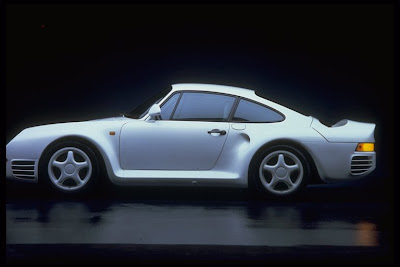
There are many famous owners of the 959. Comedian Jerry Seinfeld, who owns an extensive Porsche collection, purchased one for $700,000. Microsoft founders Bill Gates and Paul Allen each own 959s, and helped pass the "Show and Display" law in order for them to be driven on American roads.
The golfer Nick Faldo unintentionally had his 959 appear in tabloid front pages in late 1998, when spurned ex-girlfriend Brenna Cepelak trashed his 959 with his golf clubs causing a £10,000 repair bill. Other famous owners include athlete Daley Thompson and former Porsche factory driver Hans Joachim Stuck.
The 959 was used as the base for several Transformers characters, including Nightbeat, Skystalker, Hot Shot, and various GoBots/Spychangers.
The 959 appears in the following computer and video games:
Turbo Out Run (1989), as the opponent. The player races a Ferrari F40 against it.
Test Drive II: The Duel (1989), also as a competitor to a Ferrari F40.
Need For Speed: Porsche Unleashed (2000), downloadable from the Electronic Arts website as a bonus car.
Automobili Lamborghini (1997), as an opponent car, though it could be unlocked by completing championships.
Shox (2002), as a Dakar Rally car.
Project Gotham Racing 2 (2004)
In Top Gear Rally(1997) for the N64, a Porsche 959 can be unlocked under the game-name of "Type PS".
In Rad Mobile (1991), the in-game car and the sit-down cabinet resembles a 959.
Forza Motorsport (2005)
Forza Motorsport 2 (2007)
Wisedog/Dobermaxx, also known as Polgas, the main character in the Filipino comic Pugad Baboy, owns a customized Porsche 959, which he calls the Thunderdog.
technorati tags:porsche ,ferrari ,jaguar ,lamborghini ,lotus ,bugatti ,aston martin,maserati ,alfa romeo,cars,sports cars, exotic cars, classic car,porsche sports car,search sports car,porsche sports













